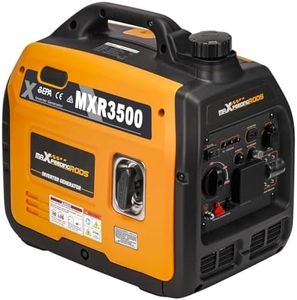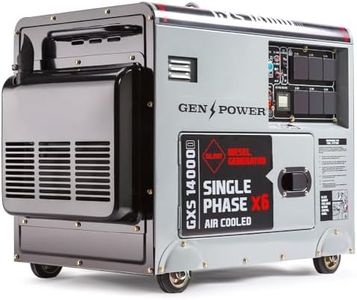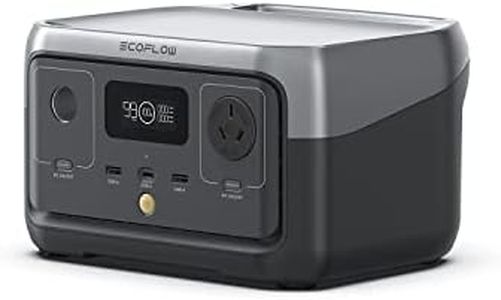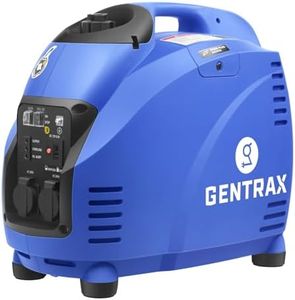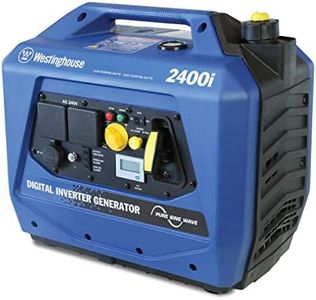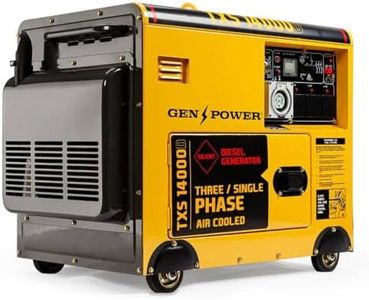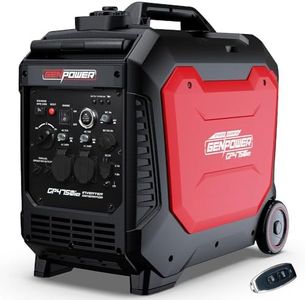We Use CookiesWe use cookies to enhance the security, performance,
functionality and for analytical and promotional activities. By continuing to browse this site you
are agreeing to our privacy policy
10 Best Portable Generators
From leading brands and best sellers available on the web.Buying Guide for the Best Portable Generators
Choosing a portable generator involves thinking about how and where you'll be using it, such as for camping, home backup during outages, or on a job site. You want a generator that delivers enough power for your needs, is safe to operate, and is easy enough to move and maintain. Start by listing the devices or appliances you want to run and use that to figure out what qualities and power output you need. Always keep in mind the safety aspects, like proper ventilation, when using any generator.Power Output (Watts)Power output, measured in watts, indicates how much electricity the generator can produce at once. This is important because all the devices you plan to use will draw a certain amount of watts, and you want a generator that can handle your peak needs. Portable generators usually range from about 1,000 to 10,000 watts. Under 2,000 watts is good for charging devices or running small appliances like lights and fans. In the 2,000 to 4,000 watt range, you'll be able to power things like refrigerators and a few other larger appliances. Go above 4,000 watts if you want to run multiple heavier-load items, such as sump pumps, air conditioners, or more power tools at once. Consider your own list of items and check their wattage to estimate what you need.
Fuel TypePortable generators can run on gasoline, propane, or sometimes diesel or dual fuel (a combination). Gasoline is very common and widely available but can be messy to store and has a shorter shelf life. Propane burns cleaner and can be stored longer, but may be harder to refill in an emergency. Dual fuel models add flexibility by letting you use either fuel, which can be useful if you don't know what you'll have available. Choose based on which fuel you’re most comfortable storing and accessing, given your planned situations.
Run TimeRun time tells you how long a generator can operate on a full tank of fuel at a certain load (often 50% load). This matters if you expect long power outages or plan to be away from the generator for extended periods. Short run times (under 6 hours) might be sufficient for short outdoor activities, but for home backup, something that can run 8-12 hours or longer without refueling is more ideal. Think about how long you want to leave the generator running and what your refueling options will be.
Portability (Weight and Wheels)Portability covers the size, weight, and ease of moving the generator. Many portable generators are still quite heavy, often 40-200 pounds. Some come with handles and wheels which make moving them easier. Lightweight models without wheels are easier to carry for camping, tailgating, or occasional work, but heavier units with wheels are better if you'll be moving the generator over your property or need more power. Think about how often and how far you plan to move it.
Noise Level (dB)The noise level, measured in decibels (dB), tells you how loud the generator will be when running. Quieter generators (under 60 dB) are better for camping or use in neighborhoods where you don't want to disturb others. Louder units (70 dB and up) might be necessary if you need a lot of power and will be using it in more isolated locations. If you’ll be around the generator a lot or are sensitive to noise, a quieter model might make a big difference.
Outlets and ConnectivityDifferent generators come with a variety of outlets (standard household, USB, RV, or twist-lock outlets). The right mix depends on what you need to plug in. For home backup, you might want transfer switch-ready outlets, while for camping you might need USB or RV connectors. Take stock of your devices and ensure the generator supports all your key plugs without needing too many adapters.
Inverter vs. Standard GeneratorInverter generators produce cleaner, more stable power, which is safer for sensitive electronics like laptops, phones, or medical devices. They are also generally quieter and more fuel-efficient, but often more expensive and limited in output. Standard generators are fine for running larger non-sensitive equipment and for higher power needs, though they tend to be louder and less efficient. Choose based on whether you plan to plug in sensitive electronics and how much power you need.
Safety FeaturesLook for safety features such as automatic shut-off when oil gets low, carbon monoxide detection, or circuit breakers. These help protect both users and connected devices. If you’re using the generator near the home or people, or in unpredictable environments, these features can provide peace of mind and prevent accidents.

